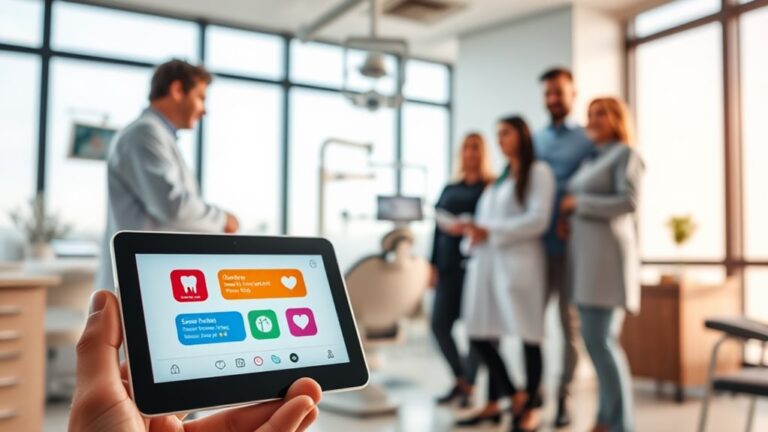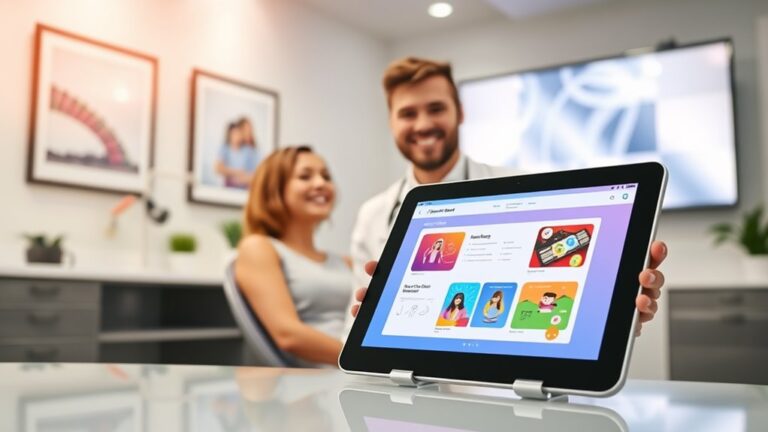7 Ways Digital Tools Boost Patient Communication & Care
You might not realize that nearly 70% of patients prefer digital communication tools over traditional methods for interacting with their healthcare providers. By embracing these technologies, you can enhance your engagement and streamline your care experience considerably. From personalized messaging to seamless scheduling, these tools can transform how you manage your health. But what specific advantages do they offer? Exploring these seven ways can reveal how digital tools not only improve communication but also elevate the overall quality of care you receive.
If you need assistance navigating these digital tools or want to learn more about how they can benefit your healthcare experience, feel free to contact us. We can connect you with experts who can provide tailored solutions to enhance your patient communication and care.
Personalized Patient Communication
Personalized patient communication is vital for enhancing your healthcare experience. By utilizing omnichannel platforms, you can choose the communication methods that suit you best—be it email, text, or apps—making it easier to connect with your healthcare providers. This approach not only increases your engagement but also helps guarantee that your preferences are respected.
Incorporating psychographic insights allows healthcare teams to tailor messages that resonate with your unique motivations and attitudes. When communication aligns with your values, it fosters a stronger connection and encourages you to take an active role in your care. Additionally, effective engagement fosters better patient-provider relationships, which can lead to a more supportive healthcare environment.
Behavioral science plays a significant role here, as it helps design interventions that address your specific needs and behaviors, leading to better health outcomes.
Moreover, the use of secure, HIPAA-compliant channels guarantees that your personal health information remains private. Automated response systems facilitate two-way communication, allowing you to ask questions and receive timely answers.
Ultimately, personalized communication isn't just about technology; it's about building trust and understanding, guaranteeing that you feel valued and supported throughout your healthcare journey.
Streamlined Scheduling Processes
A streamlined scheduling process can transform your healthcare experience by making it easier than ever to book appointments. With 24/7 online accessibility, you can schedule your visits at any time that suits you, whether it's during the day or late at night. No more waiting on hold or juggling office hours; you can book from any device with internet connectivity.
The user-friendly interface allows for quick navigation, ensuring you can secure your appointment in about a minute. Plus, you'll receive automated reminders via email or SMS, minimizing no-show rates and enhancing your accountability. Additionally, this system offers real-time appointment availability, giving you more options to choose from when scheduling your visit.
If plans change, rescheduling is just a few clicks away, freeing up valuable time for you and the administrative staff. This efficiency reduces the administrative burden, allowing staff to focus on providing high-quality care instead of managing schedules.
Real-Time Interaction Capabilities
With streamlined scheduling processes already enhancing your healthcare experience, real-time interaction capabilities further elevate patient engagement and communication.
You can now engage more effectively with your healthcare providers through secure messaging platforms like TigerConnect and Symplr. These tools guarantee that your conversations remain private and comply with HIPAA regulations, allowing you to share files, images, and even voice recordings securely.
Two-way texting also plays a key role in fostering timely communication. You can quickly ask questions, confirm appointments, or seek advice, making you feel more supported and understood. Automated reminders enhance this experience, guaranteeing you never miss an important appointment. Effective communication is crucial in ensuring that you fully understand your health conditions and treatment plans.
Furthermore, telehealth solutions offer the convenience of remote consultations via phone or video calls, giving you access to care without the need to travel.
Whether you're in need of a quick check-up or ongoing therapy, secure video channels facilitate meaningful interactions, keeping you engaged throughout your healthcare journey.
Incorporating these real-time interaction capabilities not only enhances communication but also strengthens the overall patient experience, allowing you to receive the care you deserve seamlessly.
Enhanced Care Coordination
Effective care coordination is essential for guaranteeing you receive the right treatment at the right time. With the advent of digital tools, care teams can now integrate data seamlessly, creating a unified platform for your health information. This means your care providers can easily access your complete medical history, leading to personalized care tailored to your unique needs.
Through asynchronous consultations, multiple clinicians—including specialists and nurses—can collaborate effectively. They can discuss your case within a shared platform, making sure everyone involved has the right information when they need it. This streamlined communication reduces the time spent on in-person visits and expedites decision-making. Moreover, digital health tools facilitate efficient care shifts. When you need to move between different care settings, technology guarantees you're directed to the right provider without unnecessary delays. Referral management tools help manage these shifts smoothly, minimizing the risk of inappropriate care. Notably, the integration of digital tools eliminates data silos, ensuring safer care transitions.
Reduced Administrative Burden
The integration of digital tools in healthcare not only enhances care coordination but also greatly reduces the administrative burden on providers. By utilizing automated documentation and streamlined processes, you can spend less time on repetitive tasks like note-taking and charting. Templates in electronic health records (EHRs) simplify documentation for common conditions, allowing you to focus more on patient care.
Digital efficiency shines through when you adopt AI scribes for notetaking, which increases both accuracy and speed in record-keeping. E-Prescribing systems work seamlessly with EMRs and pharmacy software, centralizing communication and minimizing manual effort. This not only reduces the risk of human error but also enhances the accuracy of patient records.
With less paperwork and more automation, your practice can function more smoothly. This efficiency not only boosts your practice's revenue through increased reimbursements but also improves overall data management. Additionally, properly designed EHR software can significantly alleviate paperwork stress, further enhancing your focus on patient care.
Improved Patient Outcomes
Improved patient outcomes are achievable through the strategic use of digital tools in healthcare. By embracing telemedicine benefits and digital health innovations, you can help patients receive timely and effective care while managing their health journeys with confidence.
Here are four impactful ways digital tools enhance patient outcomes:
- Access to Care: Telemedicine enables patients, especially in rural areas, to connect with healthcare providers without the need for travel.
- Real-Time Monitoring: Wearable technologies allow patients to track their health metrics, ensuring they stay informed about their conditions and can make proactive decisions.
- Personalized Interventions: EHRs and data analytics help create individualized treatment plans, maximizing the effectiveness of care based on each patient's unique needs.
- Early Detection: Remote monitoring can identify potential complications early, allowing healthcare providers to intervene before conditions worsen.
Increased Patient Engagement
Digital tools not only boost patient outcomes but also greatly increase patient engagement in their own healthcare. With mobile apps, patient portals, and telehealth platforms, you can easily connect with your healthcare providers. Scheduling appointments, messaging your care team, and reviewing test results from the comfort of home are now at your fingertips.
About 46% of people engage with their providers digitally, and 80% prefer these channels for appointments and follow-ups.
These tools enhance communication, offering secure messaging for timely interactions and automated reminders to keep you on track with medications and appointments. Personalized care plans and educational resources empower you to manage your health more effectively. Additionally, effective digital patient engagement strategies require careful data management, which ensures that your healthcare experience is both efficient and personalized.
By increasing your digital literacy, you can take advantage of data-driven, tailored interventions, resulting in more individualized care. Engaging with digital health programs, especially for preventative care, fosters a strong sense of involvement in your health journey.
Trust in your provider is essential; when they guide you in using these digital resources, you're more likely to engage actively.
Ultimately, digital tools not only enhance communication but also empower you to take charge of your health like never before.
Frequently Asked Questions
How Secure Is Patient Data in Digital Communication Tools?
You can trust that patient data in digital communication tools is secure. With data encryption and adherence to privacy regulations, these tools protect sensitive information, ensuring confidentiality and building trust between you and your patients.
Can Digital Tools Accommodate Patients With Disabilities?
Imagine a world where every voice matters. Digital tools, equipped with accessibility features and assistive technology, can empower you and those with disabilities, ensuring everyone receives the care and communication they truly deserve.
What Training Is Required for Staff to Use These Tools?
To guarantee staff training is effective, you'll need to focus on tool proficiency. Tailor training paths to individual needs, incorporate interactive methods, and provide real-world scenarios to enhance understanding and application of digital tools.
Are There Costs Associated With Implementing Digital Communication Tools?
Yes, implementing digital communication tools involves costs like software, hardware, and training. Conducting a cost-benefit analysis helps you navigate these implementation challenges, ensuring you invest wisely in enhancing care and communication for your patients.
How Do Digital Tools Integrate With Existing Healthcare Systems?
Imagine breezing through patient data effortlessly. Digital tools tackle interoperability challenges, enhancing user experience by seamlessly integrating with existing systems. You're empowered to provide personalized care, ensuring patients feel valued and understood throughout their health journey.
Conclusion
In a world where pigeons and smoke signals just won't cut it anymore, digital tools are your best allies in enhancing patient communication and care. They streamline appointment scheduling, send medication reminders, and even enable you to consult with your doctor from the comfort of your home. Embracing these innovations not only makes your health management easier but also allows you to focus on what really matters.
If you're looking to maximize the benefits of these digital solutions, don't hesitate to reach out to us for assistance. Our expert help can save you time, reduce stress, and significantly improve your practice. After all, who wouldn't want their health managed by a device that's smarter than most of us? Let's raise a toast to technology and the support that can help you thrive! Cheers!





